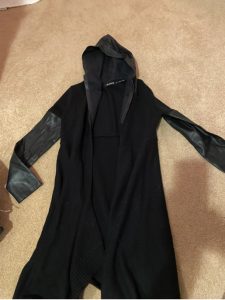I am an Absolute Mess

Over the past year, my closet has become a mess. I have shoes over the age of 10 in a pile in the corner, a green velvet dress I wore for Christmas as a teenager, a tie dye set from the beginning of quarantine that makes me look like a hot Cheeto, a flower dress with a tear that I always will “sew next year”, countless scarves that haven’t been worn since I lived in Chicago, a hat collection that my friends make fun of, and a hodgepodge of hangers of all shapes and sizes. While it didn’t used to bother me, I felt like this year I needed to clean things up.
I started with the obvious – the green dress. I bought it from Free People when I was 16 and crushed velvet, boho vibes were all the rage. I proceeded to wear it every Christmas until I was 20 in which I realized, there might be more appropriate outfits for my age. Unable to let go of my beloved dress, I left it hanging in my closet for the subsequent 8 years only to touch it every few months when it would fall off the hanger and I’d angrily ask myself, “why is this still here?”
I then moved onto the items I never wore, like the black leather cape-sweater my grandmother bought for me which she called, “mature and mysterious.” While it certainly served its purpose, I never found myself to be a Bat Woman type and never wore it once. I only kept the pleather poncho out of guilt that my grandmother would someday ask, “where did it go?” She never once asked and it found its way into my Depop pile.
After a few hours of picking through the unwanted, I finally stumbled upon the beloved items I needed to say goodbye to. These were my favorite pieces of clothing and shoes that had been through everything with me, been worn thousands of time, and were quite literally hanging onto life by a thread. Two of the most notable items were the Stuart Weitzman shoes I stole from my mom about 12 years ago and used so many times the heels fell off and a black sweater with a hole so large in the armpit my head could fit through.
And that leads me to today’s topic – Cleaning out your closet and portfolio. Because sometimes you need to get rid of the good, bad and the ugly.
WTF Are you Talking About?
Cleaning out your closet is a lot like cleaning out your portfolio. In fact, each year I run through my portfolio to get rid of my biggest winners and the biggest losers. This practice is called “Tax Loss Harvesting” – the act of selling securities at a loss to offset capital gains tax liability. 
What Do Tax Loss Harvesting & Cleaning Out Your Closet Have in Common?
You Get Rid of the Biggest Losers – When I cleaned out my closet, I got rid of my biggest losers like the green dress and the pleather poncho (see photo above). I consider these my biggest losers because they had no value to me. I never wore them, they weren’t practical and certainly were not in style. Tax Loss Harvesting is similar where you sell your portfolio’s biggest losers. These are the stocks that performed the poorest.
Note: As a rule of thumb, consider cutting your losses for stocks purchased below their cost basis (aka, they are worth less than you paid).
You Get Rid of Your Biggest Winners – When cleaning the closet, I also had to say goodbye to some of my most beloved items like the Stuart Weitzman shoes. I consider these the biggest winners because I extracted as much value from them as I possibly could. This is quite similar to your portfolio’s biggest winners which have likely returned a decent amount of value for you. For me, I like to try and capitalize on some of my gains each year to maintain my portfolio’s balance.
For example: Lets say, your portfolio target allocation is 40% Disney, 40% Tesla and 20% Apple (this is an overly simplified example and certainly not the kind of portfolio you should have – WAY TOO CONCENTRATED). Then, let’s say Disney increased in value while Tesla and Apple decreased so your portfolio ended the year with 60% Disney, 30% Tesla and 10% Apple. You might consider selling some Disney to get back to your target of 40% Disney, 40% Tesla and 20% Apple. You may also sell some Tesla and Apple to offset your Disney gains.
You Have to Consolidate – My closet wasn’t only a mess due to the clothes, I also had a disgusting amount of mismatched hangers. This made my closet difficult to organize and cluttered. When cleaning out your portfolio, tax loss harvesting isn’t just a tool to help with tax efficiencies, it can also help you clean out redundant positions. At a certain point, having more stocks doesn’t make you diversified, it can also become cluttered and difficult to keep track of.
You Make Room for the New – One of my favorite parts of cleaning out my closet is making room for new things (like the Reformation shirts I’ve been eyeing). Cleaning out your portfolio also makes room for new and perhaps better positions. You can check out how to build a diversified closet here.
 How Do I Tax Loss Harvest?
How Do I Tax Loss Harvest?
There are a few ways to tax loss harvest – manually or automatically.
Manually – Some like to “clean out their closets” on their own. The simplest way to do this is to figure out which stocks were your biggest “losers.” If you have a personal brokerage account, you need to review which stocks lost the most value. You can then sell up to $3,000 at a loss to offset capital gains tax or taxes owed on ordinary income. When you file your taxes, let’s say you do so with Turbotax, and include your brokerage documentation, they will help you file the deduction.
Automatically – Some like to hire a cleaning person to help with their closet. Similarly with portfolios, you can hire a wealth manager or a robo advisor to tax loss harvest for you. Some of the companies that do this are Betterment & soon Aura!!

Things to Be Mindful Of:
Wash Sale Rules – If an investment is sold at a loss and repurchased within 30 days, the loss cannot be claimed for tax purposes. This is due to the wash sale rule. You also have to be very careful. This is tracked via tax return, so even if you sell something at a loss in one brokerage account and try to buy within 30 days in another brokerage account, the IRS will still find out. The rule applies across brokerages.
Be careful of substantially similar ETFs / mutual funds – Tax rules are complicated. For instance, if you sell an ETF at a loss and try to repurchase the same ETF, you will violate the wash sale rule. This rule also applies to “substantially similar” ETFs/mutual funds. For example, if you plan to sell the ETF “SPY” to harvest a loss, you cannot go and buy IVV within 30 days either since they both are indexed to the S&P 500. It is safe to assume any ETF with the same benchmark is considered substantially similar.
You Have Limits – You can deduct up to $3,000 on federal income taxes with tax loss harvesting per year. That means, you can deduct up to $3,000 of net losses, and beyond that would need to be carried forward to future tax years. IE: If you deducted $6,000 this year, you would deduct $3,000 this year and the other $3,000 would be carried forward to the next year.
Your Tax Bracket – Capital gains tax is taxed at the federal and state level, so you may want to consider selling some of your “winners” if you are in a lower tax bracket year. For instance, I started a business this year and was making significantly less than I was in 2020. This put me in the lowest tax bracket. That is why I decided to sell a decent amount of stock this year (especially my biggest winners), because I paid capital gains in the lowest tax bracket.

